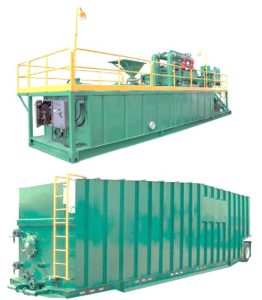Mud tanks play a crucial role in the drilling process within the oil and gas industry, serving as a vital component in the solids control system. These tanks are responsible for containing and processing drilling fluids, also known as mud, which is essential for maintaining drilling stability and efficiency.

Components of Mud Tanks
Tank Body: The main structure of the mud tank, typically constructed from steel, designed to withstand the harsh conditions of drilling operations.
Agitators: Mechanical devices installed within the tank to keep the mud mixture well-agitated, preventing solids from settling at the bottom and ensuring consistent viscosity throughout.
Shale Shakers: Integral components for solids control, shale shakers are used to separate larger solids from the drilling fluid, enhancing its overall quality and effectiveness.
Desanders and Desilters: These hydrocyclone units are employed for further separation of fine solids from the mud, improving its clarity and performance.
Mud Guns: Nozzles strategically positioned within the tank to facilitate mixing and agitation of the drilling fluid, ensuring uniformity and homogeneity.
Mud Hoppers: Devices used for introducing additives and chemicals into the mud, such as weighting agents or viscosifiers, to modify its properties as needed.
Centrifuges: In some setups, centrifuges are utilized for additional solids control and dewatering, enhancing the overall efficiency of the mud treatment process.
Functions of Mud Tanks
Mud Storage: The primary function of mud tanks is to provide ample storage capacity for drilling fluids, ensuring an uninterrupted supply during drilling operations.
Solids Control: Mud tanks facilitate the removal of unwanted solids and impurities from the drilling fluid, improving its clarity and performance downhole.
Fluid Conditioning: Through the addition of various chemicals and additives, mud tanks help optimize the properties of the drilling fluid to meet the specific requirements of the wellbore.
Recycling and Reuse: By effectively treating and recycling drilling fluids, mud tanks contribute to cost savings and environmental sustainability by minimizing waste generation.
Pressure Control: Mud tanks aid in maintaining optimal pressure levels within the wellbore, crucial for preventing blowouts and ensuring safe drilling operations.
Mud tanks are indispensable components of the drilling process, providing crucial support in maintaining drilling stability, controlling solids, and optimizing drilling fluid properties. Understanding their components and functions is essential for ensuring efficient and effective drilling operations in the oil and gas industry.
As one of the leading providers of solids control equipment, GN Solids Control offers a comprehensive range of mud tanks and associated components designed to meet the demanding requirements of drilling operations. With their commitment to quality and innovation, GN Solids Control continues to be a trusted partner for the oil and gas industry worldwide.